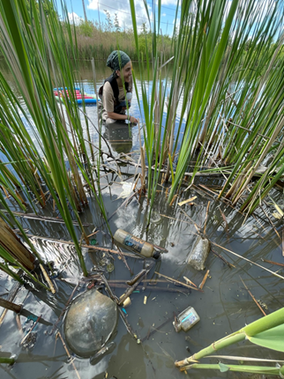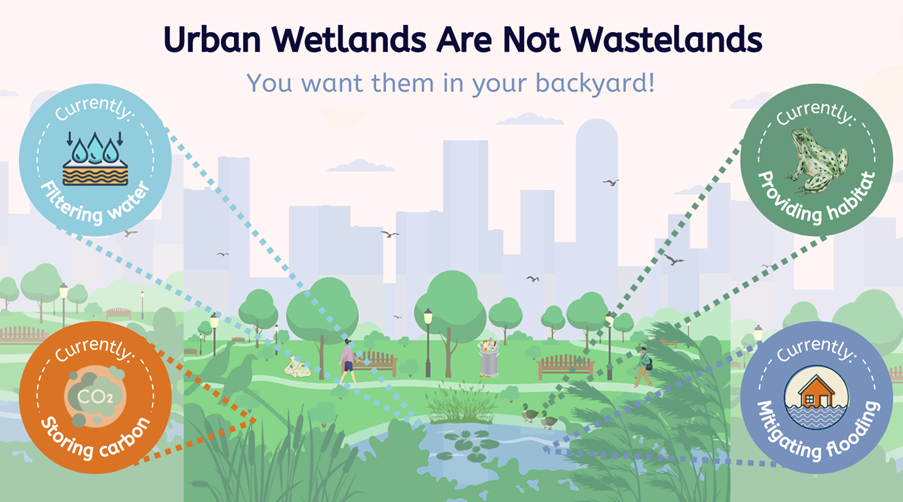Urban wetlands are not wastelands
Authored by Claire Schon, Catriona Leven, Gab Izma, Grace Lew-Kowal, Megan Jordan on November 22, 2022
 Photo courtesy of Danny McIsaac
Photo courtesy of Danny McIsaac
Our cities and towns are home to many different wetlands, and chances are, you probably encounter a wetland every day on your way to work or when you go on a walk. The wetlands within our neighbourhoods may look small, neglected, and full of trash, but these spaces are not wastelands. They are vibrant spaces that provide many services which directly benefit our communities.
Urban workhorse wetlands mitigate floods, purify water, store carbon, provide habitat for a variety of wildlife, and are important accessible green spaces in cities. There are often misconceptions about the value of these wetlands particularly when they are degraded by trash, polluted waters, and invasive species. At first glance, they might not look attractive or valuable, but when you take a closer look, you can see the water they soak up, the life that exists within them, and the green area they provide.
In the face of climate change, the risk of flooding in urban areas is only worsening. Urban wetlands provide space for water to be stored, rather than flowing into your basement. By acting as a buffer against heavy and sudden rainfall or snowmelt, even neglected wetlands still have the capacity to mitigate flooding.
Urban areas generate pollutants like heavy metals, road salts, and sewage. Although garbage can accumulate in urban wetlands, they are still able to filter pollutants and improve water quality, saving taxpayers money each year. We hear a lot about trees storing carbon but the plant and soil matter in wetlands store carbon as well which helps buffer against the effects of climate change.
Some urban wetlands are absolutely filled with invasive species, like European Common Reed, which grows so quickly and so tall that it overcrowds other plants from growing alongside it. Even wetlands full of these invasive species provide habitat for wildlife like muskrats or butterflies, and the next time you walk past your little local wetlands you should see what wildlife you can find - you might be surprised by how much is in there!
The neglected wetlands in our neighbourhoods and beside our roads are often small and dirty and do not look like they amount to much, but if you give them a chance, you will see they provide us with so many important services. The next time you encounter one of these wetlands, stop and take a moment to think about what a good job it is doing by holding water after a storm, cleaning up the salty water running off the road, or providing a spot for a bird to build a nest. Maybe you could even show these hard-working greenspaces some love and give them a hand by organizing a garbage cleanup in your local neglected wetland. Click here for more ways you can take action to support the amazing work your local wetland is doing!
Urban workhorse wetlands mitigate floods, purify water, store carbon, provide habitat for a variety of wildlife, and are important accessible green spaces in cities. There are often misconceptions about the value of these wetlands particularly when they are degraded by trash, polluted waters, and invasive species. At first glance, they might not look attractive or valuable, but when you take a closer look, you can see the water they soak up, the life that exists within them, and the green area they provide.
In the face of climate change, the risk of flooding in urban areas is only worsening. Urban wetlands provide space for water to be stored, rather than flowing into your basement. By acting as a buffer against heavy and sudden rainfall or snowmelt, even neglected wetlands still have the capacity to mitigate flooding.
Urban areas generate pollutants like heavy metals, road salts, and sewage. Although garbage can accumulate in urban wetlands, they are still able to filter pollutants and improve water quality, saving taxpayers money each year. We hear a lot about trees storing carbon but the plant and soil matter in wetlands store carbon as well which helps buffer against the effects of climate change.
Some urban wetlands are absolutely filled with invasive species, like European Common Reed, which grows so quickly and so tall that it overcrowds other plants from growing alongside it. Even wetlands full of these invasive species provide habitat for wildlife like muskrats or butterflies, and the next time you walk past your little local wetlands you should see what wildlife you can find - you might be surprised by how much is in there!
The neglected wetlands in our neighbourhoods and beside our roads are often small and dirty and do not look like they amount to much, but if you give them a chance, you will see they provide us with so many important services. The next time you encounter one of these wetlands, stop and take a moment to think about what a good job it is doing by holding water after a storm, cleaning up the salty water running off the road, or providing a spot for a bird to build a nest. Maybe you could even show these hard-working greenspaces some love and give them a hand by organizing a garbage cleanup in your local neglected wetland. Click here for more ways you can take action to support the amazing work your local wetland is doing!

